
When you think of pests, critters like mice, fleas, or termites may come to mind. Ultimately, a pest is any creature that you don’t want in your home. We’ll discuss pest control prevention and elimination tips to help you handle any pest problem that comes your way.
Pest Identification
Before you set out to eliminate pests from your home, you’ll need to know what kind of pests you have. Sometimes, that’s easy. Spiderwebs are obvious. Maybe you see mouse droppings in your workshed or a roach scurrying across your kitchen floor. But you may not be familiar with the signs left by other pests like:
- Termites: Much of the damage will be on the interior of your home, beyond the area you can see. So, look for pin-sized holes in your drywall, buckling wood, squeaky floorboards, and other potential signs of termites.
- Bed bugs: Bed bugs feed on blood, so look for bloodstains on your sheets, along with fecal droppings. They also give off a musty odor.
- Fleas: Fleas look like small black or brown specks. You may be able to spot them, or their white eggs, on your carpet or furniture. There are many methods to get rid of fleas outdoors or indoors including steam cleaning, flea spray, and nematodes.
If you don’t recognize a pest, take note of its basic characteristics: its size, color, shape, and features. Does it have wings? How many legs does it have? Is its body long or wide? Then look online for a selection of photos and see if you can find a match for what you’ve encountered.
To keep pests out of your home, recognize the signs that they’re present, seal up any potential paths of entry, and keep your home clean of anything such as dropped food that might attract them.
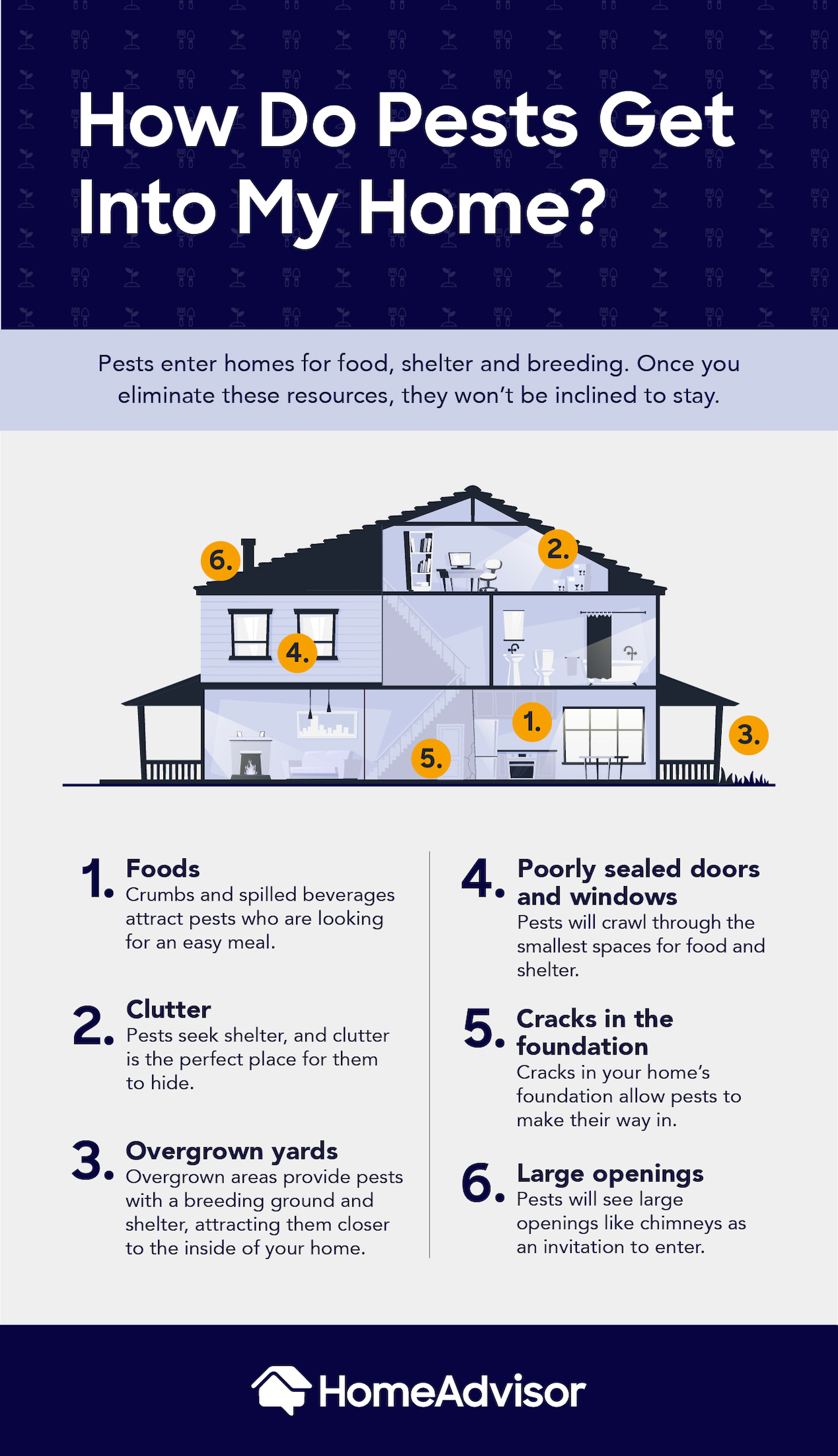
How Do Pests Get Into My Home?
You’ve probably noticed that light attracts some insects, such as moths, which navigate by moonlight. Other bugs, such as cockroaches, scurry away at the sign of a light source. In addition to light, food, clutter, and easily accessible areas make your home look attractive to pests.
Food
It pays to be aware of the foods that attract pests:
- Ants like sweets, oil and fats, and eggs.
- Fruit flies are drawn to decaying veggies and fruit.
- House flies look for liquids, and fleas feast on your pets.
- Rodents will rummage through your trash searching for anything from grains and seeds to fruit and even chocolate.
- Silverfish eat paper, clothes, and even glue in addition to more standard fare like flour and oats.
- Cockroaches will eat pretty much anything, including cheese, meat, grease, leather, glue, and pages out of your books.
The easiest way to keep from attracting pests with food is to store it in sealed airtight containers and put it away. When keeping food trash in the house, confine it to the kitchen instead of tossing it in wastebaskets throughout the house. Take that trash out frequently, and sanitize your trash cans regularly.
Clutter
Bugs like to hide in clutter such as old cardboard boxes packed with newspaper, which can be a great refuge for pests. Keeping your attic and basement clear and organized can help minimize the problem. Don’t forget outdoor sheds and other storage areas that can serve as waystations for pests heading for your home.
Piles of firewood can harbor wood-eating termites as well as carpenter ants, which make their nests in wood, so avoid piling firewood against the side of your home. (Other insects make their home in firewood, too, such as centipedes, pillbugs, and ground beetles.)
Overgrown Yards
Overgrown yards can serve as hiding places, too. They can be great breeding grounds for pests and can create a pathway to your home. To stop insects and other pests from hiding out and breeding in your yard, rake and clear out any leaves and trim your grass regularly. Be particularly wary of standing water where mosquitoes can breed.
Poorly Sealed Doors and Windows
Pests are always looking for a way in, and poorly sealed entryways provide them with the perfect opportunity. Look for any gaps around your doors and windows; if you find any, seal them with caulk.
One of the easiest ways to access your home is through a gap under the front door, so consider installing a door sweep. A door sweep is typically a long piece of plastic or rubber that you fit across the bottom of your door to close the gap.
In addition to cracks around your doors and windows, cracks around dryers, vents, and exhaust fans can be inviting. So are openings that house wiring such as cable television wires, and for HVAC systems and plumbing.
Cracks in the Foundation
Similar to cracks in doors and windows, cracks in the foundation can let bugs in, and they can damage your foundation. Carpenter ants and termites are common pests that are attracted to your foundation and the wood around it.
You may want to consider keeping foliage away from the foundation of your home and regulating moisture levels to reduce the likelihood of pests.
Large Openings
If small openings are gateways to your home for pests, large openings are more like highways. Consider installing a chimney cap and filling large holes with wire mesh. Take a close look at your siding to see if you recognize areas that you need to fill.
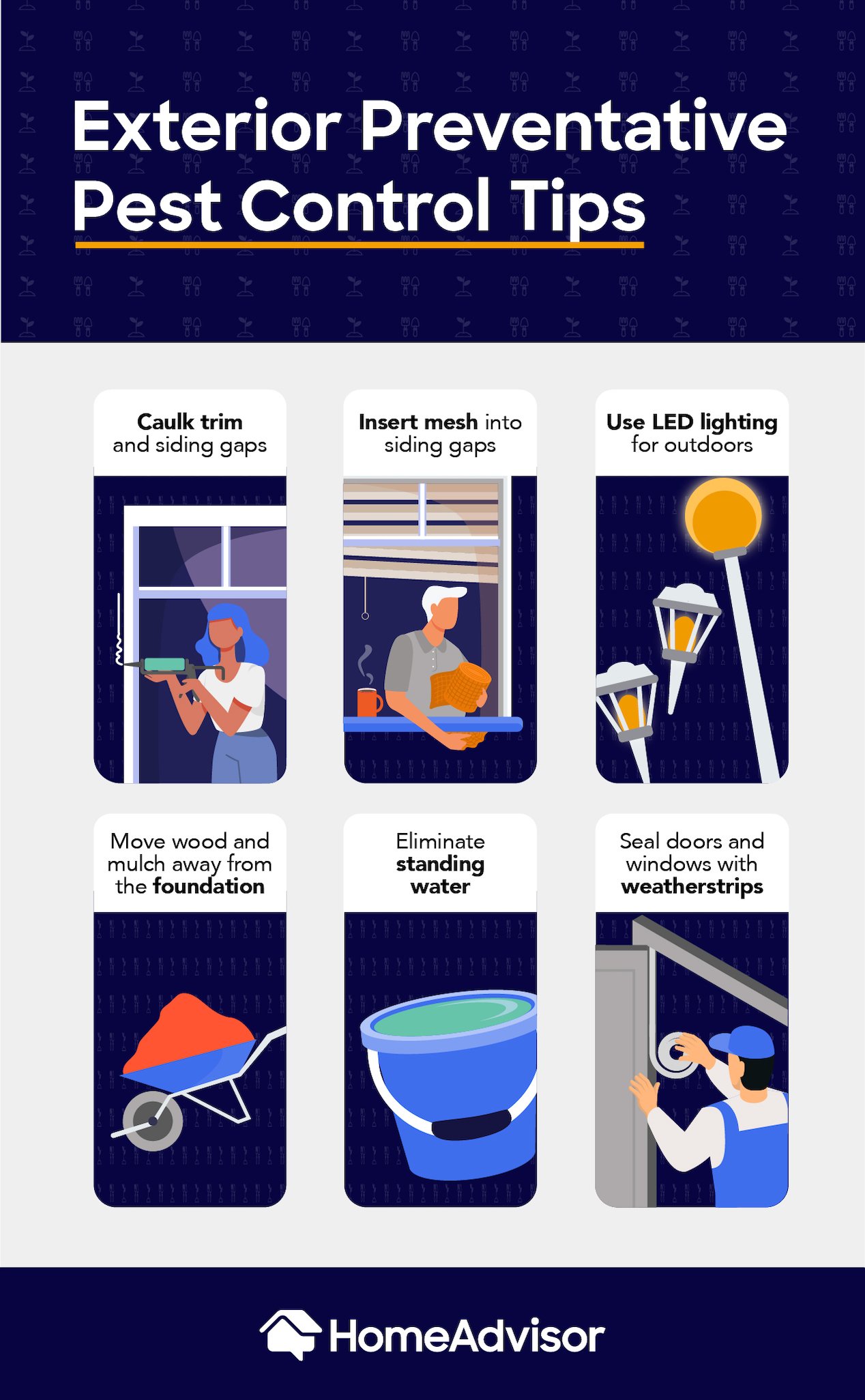
Exterior Preventative Pest Control Measures
In addition to mowing your lawn, clearing away leaves, and maintaining your woodpile, there are other things you can do outside your home to keep pests from gaining a foothold on your property and access to your home. Here are a few:
Caulk Trim and Siding Gaps
Look for any gaps between your trim and siding, then fill them with acrylic latex caulk. Use a wet piece of cloth to clear away any excess caulk, and use your wet finger to smooth the caulk bead.
Insert Mesh Into Siding Gaps
Like we mentioned above, you’ll want to keep pests from accessing your home through foundation gaps and siding joints. You can fill hairline cracks or smaller using urethane caulk or an epoxy concrete repair kit. This material will keep bugs from getting in.
You may need a mirror to check for cracks under siding joints. When you find gaps, insert some copper mesh. This method is a great way to block pests from accessing your home. Use a screwdriver to stuff a generous amount of mesh into the gaps, but leave about a half inch to fill with expanding foam sealant to complete the job.
Use LED Lighting Outdoors
The kind of light you use matters. LED lighting with a warm color temperature is your best bet as it tends to attract fewer bugs. And it’s 90% more energy-efficient than traditional bulbs. Insects seem to be most attracted to yellow lights that emit a lot of heat.
Positioning lights closer to the ground helps, too, because most bugs are attracted to lights as they fly through the air rather than when they’re on the ground. Using multiple sources will spread the light around and keep them from being drawn to a single bright spot, which can happen when artificial light throws off their internal navigation.
Fill Soffit Gaps With Foam
The soffit is the exposed surface of a roof or overhang; gaps can form where it meets the wall of your home. Large soffit gaps can be havens for pests and routes for them to enter your home. Stinging insects can build nests in these gaps and wreak havoc, disappearing before you can get to them and emerging to swarm family members and pets. Birds can build nests in this area, too.
To keep this from happening, close the gaps using expanding foam. When it dries, use a utility knife to trim any excess away.
Seal Doors and Windows With Weatherstrips
Weatherstripping can seal gaps at windows, doors, and basement sashes. Clean the surface to make sure the adhesive on the back of the weatherstripping will adhere well. This step can also save you money on energy bills because it will help seal in warm air in winter and cool air from your HVAC unit in summer.
Move Wood and Mulch Away From the Foundation
Woodpiles, as we know, can attract termites and carpenter ants, but the problem goes further than that.
Moisture can attract pests such as spiders and centipedes.
Plant garden beds and shrubs away from the foundation to avoid creating moist, pest-friendly environments close to your home. Also, frequently turn any mulch near the house to keep moisture at a minimum, and rake damp soil and mulch away from low wood and basement window frames.
Eliminate Standing Water
Keep your property free of mosquito breeding grounds. If you notice low spots where water pools when it rains, create drainage that carries the water away from your home. Also, change the water in any birdbaths or water fountains every couple of weeks, and be sure to keep your swimming pool well maintained if you have one.
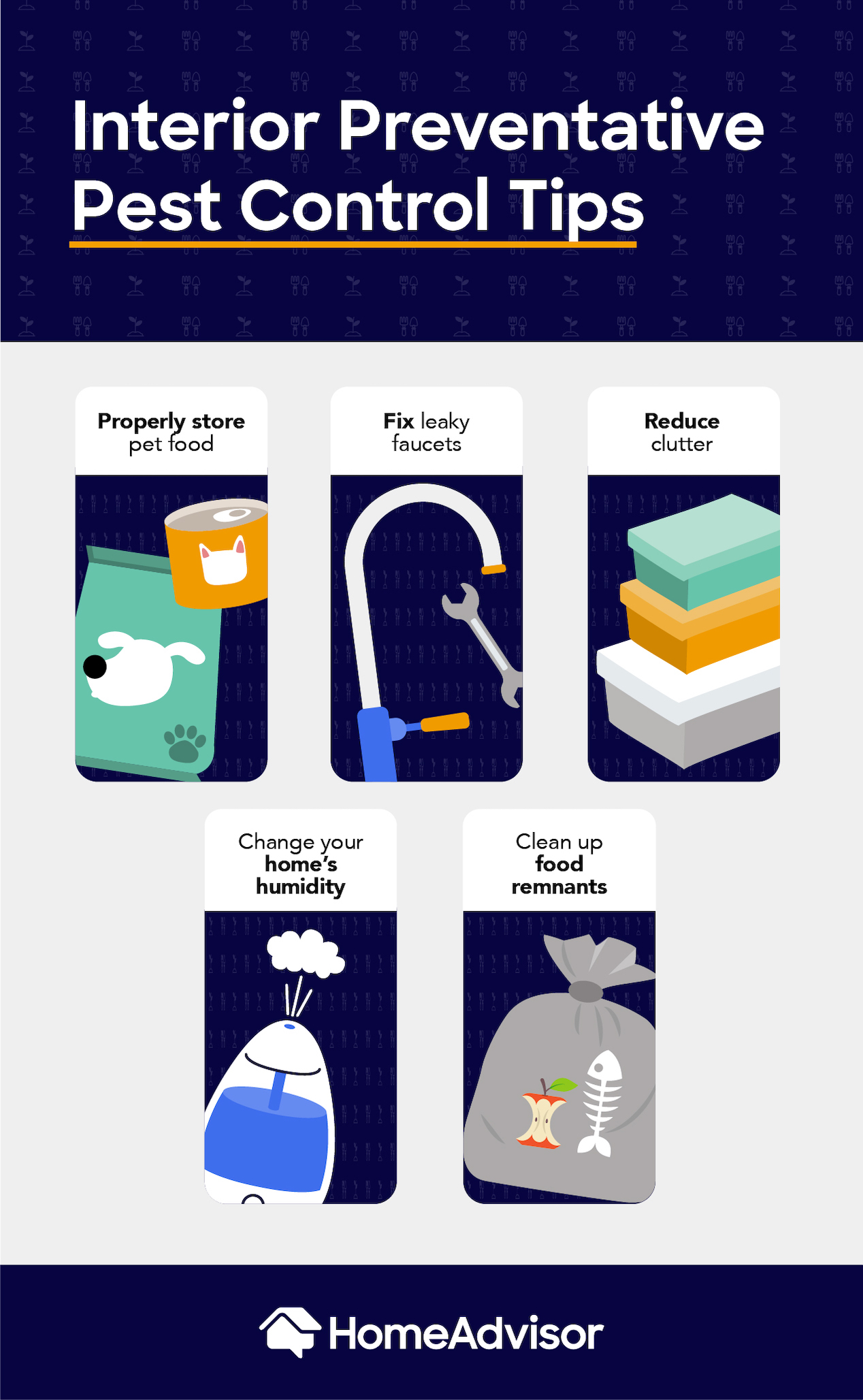
Interior Preventative Pest Control Measures
No matter how well you barricade your home’s exterior against pests, some are still likely to make it through. Here are some ways to make your home as inhospitable as possible to them.
Properly Store Pet Food
Use sealed plastic containers or a lidded metal trash can to store kibble and other pet food. Metal is preferred because mice can’t scale the sides of the can. Don’t leave pet food outside because it can attract other pests, such as raccoons.
Fix Leaky Faucets
Pests need water to live, so deprive them of an easy source by repairing dripping water faucets and leaking sink traps. Damp towels and sponges can also attract them.
Change the Humidity in the Home
Some pests, like spiders and cockroaches, enjoy humid environments. A dehumidifier can help if you keep your home’s humidity level between 40% and 45%, which is less ideal for these pests.
Reduce Clutter
As mentioned earlier, reducing clutter will eliminate hiding places for pests that don’t want to be found.
Clean Up Food Remnants
Make sure your kitchen counters, dining room tables, and other eating areas are kept free of crumbs, grease, and other potentially edible pest attractions. If you have a pet, make sure to seal their food in an airtight container.
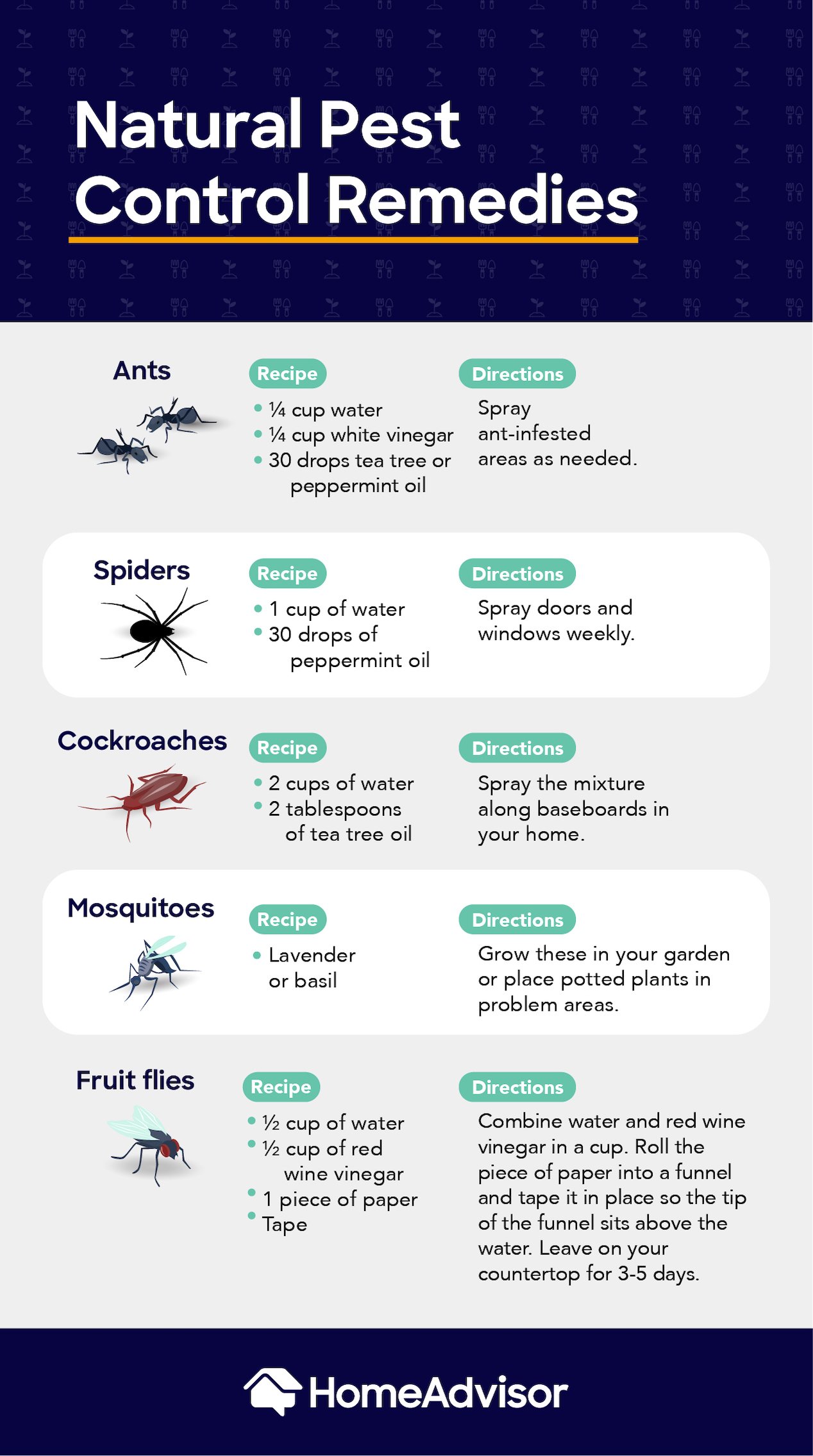
Natural Pest Control Remedies
You don’t have to put up with toxic fumes or poison traps to get rid of pests. Natural methods can work, too. Many believe these homemade remedies can help deter pests, but they should never be used to combat an active infestation.
- Bed bugs: Extreme heat or cold kills bed bugs, so steam clean your carpets and upholstery and wash linens on your washer’s hottest setting.
- Fleas: Spread nematodes in your yard to combat fleas. You can find them at a local home store. Just mix them with water and spray them in your yard. These microscopic worms feed on the eggs and larvae of fleas.
- Mosquitoes: You can repel mosquitoes by growing basil or lavender in your garden or placing potted plants in problem areas.
- Fruit Flies: To get rid of fruit flies, create a natural fly trap using a piece of paper. Roll it into a funnel, and tape it in place with the tip of the funnel above a cup of water and red wine vinegar on your counter. The fruit flies will be drawn to it and will collect in the funnel in about three to five days.
- Spiders: Thirty drops of peppermint oil mixed with a cup of water can keep spiders away if you spray the solution on doors and windows every week.
- Ants: Mix white vinegar with 30 drops of tea tree or peppermint oil into a quarter-cup of water and spray ant-infested areas as needed.
- Cockroaches: Mix 2 tablespoons of tea tree oil with two cups of water, put the solution into a spray bottle, and spray along the baseboards in your house.
- Gnats: Rid your home of gnats by creating a trap made from apple cider vinegar and a few drops of dish soap. The gnats will be attracted to the vinegar, but the sticky soap will trap them.
Safety Precautions for DIY Pest Control
There are some things to keep in mind when you take on a pest control project.
Even if you opt for a natural pest control remedy, double-check that it’s safe to use around children and pets. Some essential oils may be harmful to children and animals. If in doubt, don’t use them.
If you’re using pesticides, make sure you use them as intended. Follow the directions on the label and don’t use more than the indicated amount because doing so could make your family or pets sick.
Don’t use outdoor pesticides indoors. These chemicals remain toxic longer so they don’t dissipate quickly in the open air. Using them in an enclosed environment can be dangerous for this reason.
Only store pesticides in the containers they came from, and don’t use pesticide containers to store any other contents. Toxic materials need to be stored safely and contained out of reach of children.
When to Call a Professional
You may encounter a pest problem that you can’t control by yourself. Then it’s time to contact a local pest control professional.
Termite fumigation isn’t something you should undertake on your own. Neither is rodent control, such as mice, rats, or squirrel control, which can carry health risks. Pest control specialists can use specially designed lighting to keep squirrels away and deploy traps strategically so they catch the squirrels and set them free elsewhere.
Relocating these animals is a better option than exterminating them because of the poisons involved and the risk that can come from rotting carcasses that may carry disease-bearing pests such as ticks and fleas.
If you face any of these problems, do a price comparison of pest control specialists in your area.
Conclusion
When it comes to pest control, prevention is the best defense. Sealing your home, storing food and other material that may attract pests, removing clutter, and keeping your yard tended will reduce the chances that you’ll have to deal with unwanted visitors.
But if those steps don’t work, you have options available to you. You can try responsibly using chemical pest control products, or you can try some of the natural methods mentioned above. If active infestations are present, you should call pest control to combat the situation. Choose one in your area with stellar reviews and great recommendations and the problem will be solved in no time.
 Squirrel Pest Control
Squirrel Pest Control  Rodent Control: A Primer
Rodent Control: A Primer 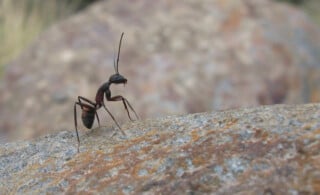 Ant Control 101
Ant Control 101 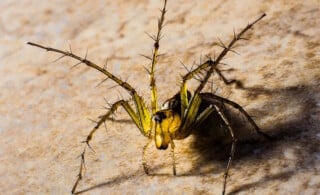 Is Your Spider Problem a Problem?
Is Your Spider Problem a Problem? 

Are You Familiar With This Topic? Share Your Experience.